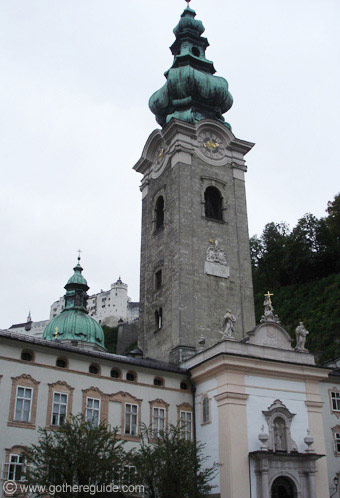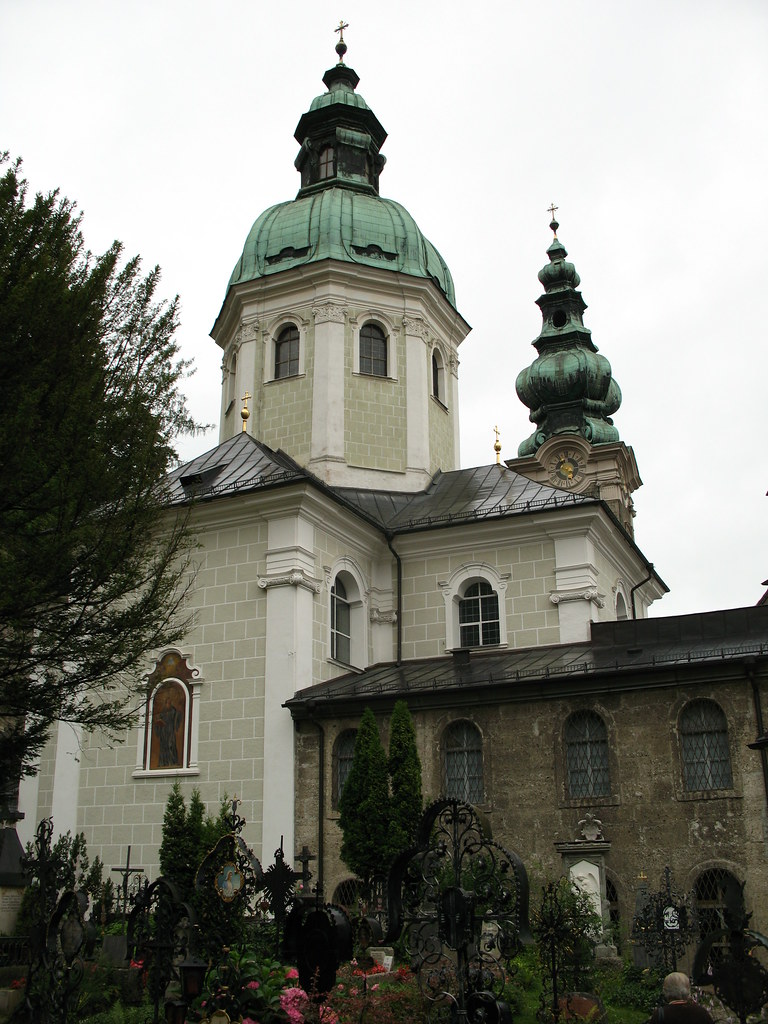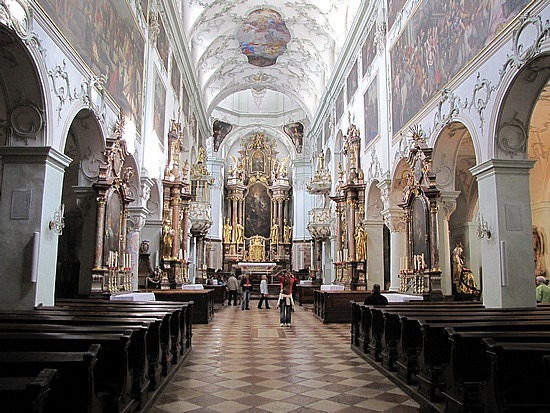St Peter's Abbey, Salzburg
Abbey of St. Peter, and St. Peter's Abbey (Latin Archiabbatia sancti Petri Salisburgensis ), in Salzburg is the oldest existing monastery in the German-speaking world. The monks live according to the Rule of St. Benedict.
History
St. Peter in Salzburg was founded by St. Rupert to 696 to the mission in the south-eastern Alps or revived. Finds of remains of walls under the altar of today's collegiate church, which were dated to the fifth century, suggest that in the days of St.. Severin at this point a first church building was available, which was probably built by a small Romanesque monastic community and renewed by Rupert and expanded. Until 987 the office of bishop with the abbot was joined by personal union, but remained St. Peter in spite of warnings this year separation of the two offices until 1110, the residence of the Archbishop of Salzburg.
In the Middle Ages, the Abbey of St. Peter was especially known for its excellent writing school. It is also the mother monastery of the Benedictine Admont in Styria. 1074 were sent to Admont to begin a monastic life there 12 monks of St. Peter. In the 15th century the abbey of Melk Reform joined. Built in 1622 Archbishop of Paris Lodron the Benedictine University of Salzburg, which was up to their abolition in 1810 closely connected with the monastery.
The efforts of Abbot Petrus Klotz to a Catholic University were rewarded in 1926 by the establishment of the preparatory course of the Benedictines, the College of St. Benedict, - a process which should lead to the re-establishment of the University of Salzburg later. In 1927, the collection of St. Peters for Archabbey. In the period of the Nazi regime expelled the monks, the monastery but not canceled. The monks returned after the war. Most recently, after the short abbacy of Abbot Bruno Becker ( 2009-10 ) from April 2010 to April 2013 P. Benedict Roeck OSB Archabbey as an administrator.
On 30 January 2013, the Convention of the pen Prior Korbinian Birnbacher elected as the new abbot of St. Peter. He was christened on April 21, 2013 in the Collegiate Church, the blessing by the Archbishop of Salzburg. The pin includes currently 21 monks (as of September 2012).
See also: List of abbots of the congregation of Saint Peter
Collegiate Church
The first monastery church of St. Peter was built around 696, when Rupert ( Hruodpert ) renewed the there probably existed since the late antique Romanesque monastic community. The current church dates back to the core of a building that was built in 1125-1143 and consecrated in 1147. The mighty church tower, which was increased romanisierend in 1400, originates in the core to the 9th century.
The main organ was created by the Mainz organ builder Heinrich Traxdorf on the rood screen in 1444. The Gothic ribbed vaults are available in the lobby. In the style of the Renaissance, the church itself in 1605 /06 has been redesigned vaulted 1619/20 and 1622 provided with a slender central dome. The distinctive Baroque onion dome was built under Abbot Seeauer 1756. The two high altars are considerably by Martin Johann Schmidt ( " Kremser Schmidt " ) designed. Also of Mary - SAEUL Altar is known with a Madonna of 1425th The interior of the church is new 1760-66 by Roccaillestuck and ceiling paintings with rich rococo style in collaboration with Franz Xaver König, Lorenz Härmbler, Johann Högler, Benedict Zöpf and other Rococo style, with an old Romanesque building structure remains clearly visible. The large ornate Rococo lattice ( Church cover grille ) was designed by Philipp Hinterseer.
Chapels in the church are the Wolfgang Chapel and the Chapel of the Holy Spirit.
The small Chapel of Saint Catherine ( Maria Zeller Chapel ), founded in 1215 by Duke Leopold VI. , Is grown on the southern cross arm of the church and was ordained in 1227. It has a groin vault. The Rokokostuckaturen of 1792 were carried out by Peter Pflauders.
The nearby St. Mary's Chapel (formerly St. Veit chapel called ), installed in the monastery of St Peter has preserved its Gothic spirit entirely. It is probably the oldest surviving Gothic building in the city. Here lies John Staupitz Abbot († 1524) is buried, the religious superior was ( as a former Augustinian ) by Martin Luther once.
Library
St. Peter houses the oldest library in Austria. The most precious among the 800 manuscripts is the brotherhood book, which was created 784 by Bishop Virgil. Through continuous expansion, the library has grown to 100,000 volumes, which works on Benedictine monasticism, medieval church history, art history and Salisburgensia form the aggregate priorities. Special stocks are the incunabula and early printed books, as well as the graphics collection with the Andachtsbildchensammlung of P. Gregor Lechner riding and a map collection.
1768 Abbot Beda Seeauer the cell library remodel in Rococo style. It was restored in 1999 and is accessible only with special permission. The library is usable by appointment.
In November 2006, parts of the library's collection that were duplicated, sold to various libraries, collectors and universities in Austria and Germany.
Archives
The archive is designed to manage the pin and the exploration of its history. It contains written records from the 8th to the 20th century, and includes the following stocks:
- Certificate number: 4300 certificates until 1700
- Handwriting Series A: chronicles, diaries, Chapter protocols, visitations, foundations, obituaries and rubella, inventories, account books, etc.
- Handwriting Series B: Official records of the manorial system ( Urbare, Basic Books, Business Books Hofrichter ).
- Files: documents and correspondence of the abbots, the Conventual, the combing and other administrative bodies of the pen; Manorial records
- Collections: photos, maps and plans.
Music Archives
Due to the contact with prominent Salzburg musicians has St. Peter a significant, even autograph tradition with works by Johann Ernst Eberlin, Anton Cajetan Adlgasser, Leopold and Wolfgang Amadeus Mozart, Johann Michael Haydn, Sigismund von Neukomm, Robert guides and Karl Santner.
Pen Music St. Peter
The monastery of St. Peter 's always been famous for its musical and cultural interaction. The pin music and the collegiate church choir of St. Peter, have this much in shaping and framing of church festivals. Especially works by Haydn, W. A. Mozart and others (including contemporary composers ) will be performed. Mozart's Great Mass in C minor should be with his wife Constanze as soprano soloist, probably listed on 26 October 1783 here.
Other Collections
Andachtsbildchensammlung, photo collection, collection of paintings, graphic collection, church treasures, crafts, mineral collection, furniture depot, collection of musical instruments, coins Cabinet, Naturalienkabinett (not in use )
Institute in St. Peter
To give the German Benedictines and Benedictine the opportunity to retrain in monastic themes that Salzburg has Äbtekonferenz built in 2000, the Institute of Benedictine studies. It is the study of the Rule of Saint Benedict ( Rule of St. Benedict ) and the holding of courses. The line has held Dr. Sr. Michaela Puzicha OSB.
St. Peter 's by the activity of P. Adalbero Raffelsberger one of the early places of liturgical renewal in Austria. In 2001, the Liturgical Institute of the Austrian Bishops' Conference was affiliated.
Stiftskeller
The restaurant within the monastery walls monastery cellar called St. Peter, and claims for itself because of the documentary mention in 803 claims to be the oldest restaurant in Central Europe.
St. Peter's Cemetery
With its " catacombs " are in the cemetery of the monastery connected locate the oldest surviving architectural achievements of Salzburg. Also a great number of chapels makes the cemetery into one of the most impressive in Central Europe.









